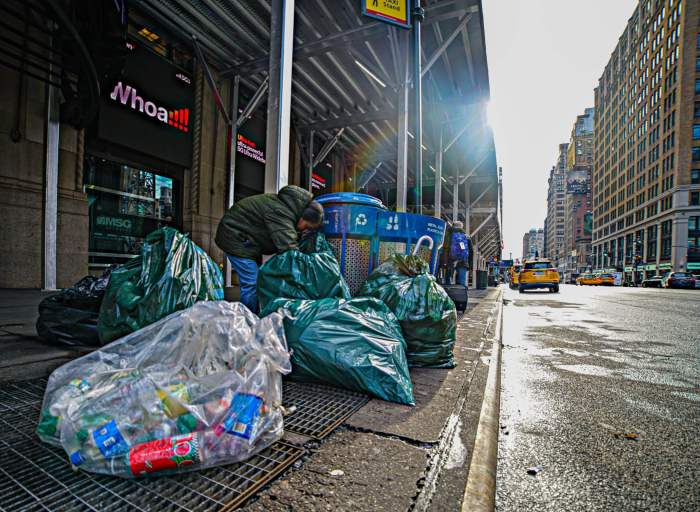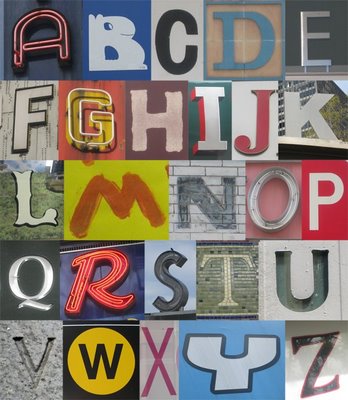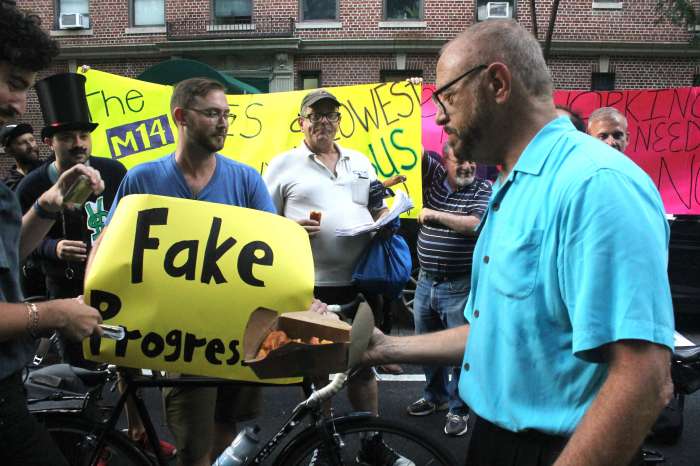O.W.S. and BIDs
To The Editor:
Re “‘Occupy’ movement is a wake-up call to Washington” (talking point, by Margaret Chin, Oct. 20):
The Occupy Wall Street movement is a wake-up call to the people who govern New York City, as well.
The business improvement districts spreading across the city are creating a layer of bureaucratic administration between people and their government — helping to set up the climate against which Occupy Wall Street is protesting.
The main purpose of the BIDs is to encourage shopping and consuming — major factors leading to the decline of our environment. These are elements crucial to where we go from here — as a civilization — that O.W.S. is addressing, and which Ms. Chin is right in saying that we must all address.
We don’t need to improve business. Business is doing just fine — at the expense of the rest of us!
Sally Lindsay
Get rid of government
To The Editor:
Re “‘Occupy’ movement is a wake-up call to Washington” (talking point, by Margaret Chin, Oct. 20):
You’re totally wrong. What people want is the complete deconstruction of this disgusting enforced system that is built on nothing but greed, manipulation and exploitation. This does not mean we want current governments to do more for us. This means we want to get rid of current government and government as a whole because nobody deserves to be in power and dictate all of our lives.
The tools that are in place to support greed, manipulation and exploitation must be removed completely. There’s your answer for “what are they protesting about?”
Julian Cahillane
Protesters must look within
To The Editor:
Re “Can’t deny Occupy” (editorial, Oct. 13):
While I am very supportive of the protesters’ grievances, angers, rage, etc., I am not in agreement that 1 percent of the population is inflicting economic “injustice” on the 99 percent.
The values and consciousness of the 100 percent, to a very large degree, are driving the seeming “injustice.”
Michael Gottlieb
Avenue A for ‘Arihood’
To The Editor:
Re “Photographer Bob Arihood captured the grit and glory of East Village street life like no one else” (news article, Oct. 20):
Few people are harder to memorialize than Bob Arihood due to his private nature. He spoke through his photography. You did him justice in this touching and moving piece.
Bob’s legacy will be long-lasting on Avenue A, long after the tributes have faded.
Avenue A from now on — as far as I’m concerned — is Avenue Arihood.
Shawn Chittle
Schooling N.Y.U. on civility
To The Editor:
Re “N.Y.U. — so sensitive” (Scoopy’s Notebook, Oct. 13):
Thanks to Community Board 2 Chairperson Brad Hoylman for a clear, considered response to Alicia Hurley’s ludicrous charge of “lack of civility” on the part of the board toward N.Y.U.’s Plan 2031.
In view of the condescending tolerance, bordering on irritation, with which the university treats objections to its construction objectives, Mr. Hoylman’s statement is a model of dignified restraint.
Israel Santiago
Objections aren’t incivilities
To The Editor:
Re “C.B. 2 angered after N.Y.U. goes to the media first” (news article, Sept. 29):
I’m really surprised at N.Y.U. Vice President Alicia Hurley’s comment that there is “lack of civility” at Community Board 2 meetings. As someone who has attended and spoken at several C.B. 2 meetings with regard to N.Y.U.’s Plan 2031 proposals, her remarks appear to me to be not very well thought out.
What she mistakenly calls “lack of civility” is the community’s public objection to N.Y.U.’s extraordinarily overambitious plans that would overdevelop the area now known as “the superblocks.” Objections aren’t incivilities.
Sylvia Rackow
Uncivil and dangerous
To The Editor:
On Mon., Oct. 10, I witnessed a hit-and-run at around 9 p.m. A motorcyclist headed south on Bowery was clocked by a motorist and sent flying. The motorist turned onto Prince St., never even stopped.
A few pedestrians (and me with my bike) went to help the motorcyclist as he sat dazed in the middle of Bowery, seemingly not hurt — although his bike was a mess. A few pedestrians used their cell phones to call the cops.
And what do the backed-up motorists immediately start doing before this poor cat has even caught his breath? Leaning on their f—— horns, of course.
This comes one day after a motorist tried to run me off the road, screaming at me, “The road is for cars!” Ironically, this happened on Church St., right in front of Ground Zero — just the kind of thing that New Yorkers famously didn’t do to each other for the first six months after 9/11, when we were all shell-shocked.
This s— makes my blood boil.
Bill Weinberg
BID and 135 Bowery
To The Editor:
Re “City Council, Chin pull the plug on Bowery old-timer” (news article, Sept. 22):
The issues surrounding 135 Bowery are about respecting neighborhoods, being good neighbors, building on good business practice and finding a comprehensive shared vision for all of our Lower Manhattan communities.
It’s a great idea to build low-income office space in our struggling economy. Investing in spaces that would allow entrepreneurs to create job-producing ideas, services or manufacturing would help diversify the local economy and attract new blood to the area. Good idea, Peter Yau!
It just doesn’t have to be built on a site that just happens to contain one of the most valuable buildings in this neighborhood!
The Chinatown Business Improvement District Steering Committee, spearheaded by co-chairperson Peter Yau, fought hard to bring to Chinatown a solid community organization that would allow the neighborhood to determine its own future. Their purpose is to help Chinatown get back on its feet. Though not agreed to by everyone, the BID did have major support and its organizers had an understandable desire to have a say in Chinatown’s recovery.
Now the residents and businesses that inhabit the Bowery have asked for the same right: to determine our own neighborhood. We think 135 Bowery, preserved, better serves our community of the Bowery and the nearby communities of Little Italy, the Lower East Side and Chinatown.
This restored building, along with the beautiful Stanford White Bowery Savings Bank and a few neighboring houses, could become a focus of another economy — a “historical” one; one that draws in tourists and history buffs and sends them back out into our neighboring communities.
This could be the gateway to all of the unique centers here: the Asian American Arts Center, The Museum of the Chinese in the Americas, St. Augustine’s Church (with its restored slave galleries), the Tenement Museum, The Italian American Museum, Clemente Soto Velez Cultural Center, The Merchant’s House, the Eldridge Street Synagogue, St. Patrick’s Old Cathedral.
This could invigorate all the small businesses that surround these institutions. The local artists community will be better served by the small-scale nature of a preservation project.
The BID has an opportunity to lend its considerable weight and expertise to a solution that allows for all of our communities to welcome it as a good neighbor and partner in solving problems — together.
K Webster
E-mail letters, not longer than 250 words in length, to news@thevillager.com or fax to 212-229-2790 or mail to The Villager, Letters to the Editor, 515 Canal St., Suite 1C, NY, NY 10013. Please include phone number for confirmation purposes. The Villager reserves the right to edit letters for space, grammar, clarity and libel. The Villager does not publish anonymous letters.
















